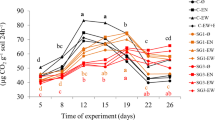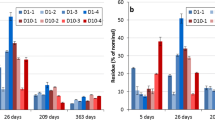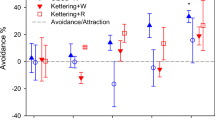Abstract
Because of the wide use of pesticides in agriculture, there is still a need of higher-tier field studies to assess ecotoxicological effects of commercial formulations on a wider variety of non-target soil organisms such as soil annelids. We here tested the effects of different concentrations of two fungicide formulations, i.e., Cuprafor Micro® (composed of 500 g kg−1 copper oxychloride) and Swing Gold® (composed of 50 g l−1 epoxiconazole and 133 g l−1 dimoxystrobin) on two families of terrestrial oligochaetes (Lumbricidae and Enchytraeidae) after 1 month of exposure. We also assessed the feeding activity of soil organisms using the bait lamina method. Along with the feeding activity, the enchytraeid density, diversity and communities were not different in the control and the contaminated plots. By contrast, epigeic earthworms were absent and earthworm diversity and densities of anecic species decreased significantly in the plots contaminated at ten times the recommended dose of the Swing Gold® formulation. The copper fungicide (at 0.75 and 7.5 kg Cu ha−1) and the treatment with the pesticide mixture (Cuprafor Micro® at 0.75 kg Cu ha−1 and Swing Gold® at the recommended dose) did not affect Oligochaeta communities compared with the control, except the Shannon index for earthworms in the mixture of both fungicides. Responses of the two annelid families to the tested pesticides were different with higher effects observed on the diversity and the community structure of earthworms compared with enchytraeids. This study allowed detecting early changes on oligochaete populations after pesticide application.




Similar content being viewed by others
References
Altieri MA (1999) The ecological role of biodiversity in agroecosystems. Agric Ecosyst Environ 74:19–31
Amorim MJB, Römbke J, Soares AMVM (2005) Avoidance behaviour of Enchytraeus albidus: Effects of Benomyl, Carbendazim, phenmedipham and different soil types. Chemosphere 59:501–510
Bandow C, Ling Ng E, Schmelz RM, Paulo Sousa J, Römbke J (2016) A TME study with the fungicide pyrimethanil combined with different moisture regimes: effects on enchytraeids Ecotoxicology 25:213–224
Bart S, Laurent C, Pery ARR, Pelosi C (2017) Difference in sensitivity between earthworms and enchytraeids exposed to two commercial fungicides. Ecotoxicol Environ Saf 140:177–184
Beylich A, Graefe U (2012) Relationships between microannelid and earthworm activity. In: Schrader S, Schmelz RM (ed) Newsletter on Enchytraeidae, 12, Landbauforschung, vTI Agriculture and Forestry Research, Special Issue 357. Thünen-Institut, Braunschweig, pp 1–12
Bland JM, Altman DG (1995) Multiple significance tests - the Bonferroni method. Br Med J 310:170
Booth LH, Heppelthwaite V, McGlinchy A (2000) The effect of environmental parameters on growth, cholinersterase activity and glutathione S-transferase activity in the earthworm (Aporrectodea caliginosa). Biomarkers 5:46–55
Bouché MB (1977) Stratégies Lombriciennes. In: Lohm U, Persson T (eds) Soil organisms as components of ecosystems. Ecol. Bull. vol. 25, Stockholm, pp 122–132
Brock TCM, Hammers-Wirtz M, Hommen-Writz M, Hommen U, Preuss TG, Ratte H-T, Roessink I, Strauss T, Van den Brink PJ (2015) The minimum detectable difference (MDD) and the interpretation of treatment-related effects of pesticides in experimental ecosystems. Environ Sci Pollut Res 22:1160–1174
Casabé N, Piola L, Fuchs J, Oneto ML, Pamparato L, Basack S, Giménez R, Massaro R, Papa JC, Kesten E (2007) Ecotoxicological assessment of the effects of glyphosate and chlorpyrifos in an Argentine soya field. J Soils Sediment 7(4):232–239
Christensen OM, Mather JG (2004) Pesticide-induced surface migration by lumbricid earthworms in grassland: life-stage and species differences. Ecotoxicol Environ Saf 57:89–99
Datta S, Singh J, Singh S, Singh J (2016) Earthworms, pesticides and sustainable agriculture: a review. Environ Sci Pollut Res 23:8227–8243
DeLonge MS, Miles A, Carlisle L (2016) Investing in the transition to sustainable agriculture. Environ Sci Policy 55:266–273
Didden WAM, Römbke J (2001) Enchytraeids as indicator organisms for chemical stress in terrestrial ecosystems. Ecotoxicol Environ Saf 50:25–43
Domínguez A, Bedano JC (2016) Earthworm and enchytraeid co-occurrence pattern in organic and conventional farming. Soil Sci 181(3–4):148–156
Edwards CA (2004) Earthworm ecology, 2nd edn. CRC, Boca Raton
Edwards CA, Bohlen PJ (1996) Biology and ecology of earthworms, 3rd edn. Chapman & Hall, London
Eijsackers H, Beneke P, Maboeta M, Louw JPE, Reinecke AJ (2005) The implications of copper fungicide usage in vineyards for earthworm activity and resulting sustainable soil quality. Ecotoxicol Environ Saf 62:99–111
Frampton GF, Jänsch S, Scott-Fordsmand JJ, Römbke J, Van den Brink PJ (2006) Effects of pesticides on soil invertebrates in laboratory studies: a review and analysis using pesticides sensitivity distributions. Environ Toxicol Chem 25(9):2480–2489
Giraudoux P (2017) pgirmess: Data Analysis in Ecology, R package version 1.6.7
Gobat J-M, Aragno M, Matthey W (2004) The living soil, fundamentals of soil science and soil biology. Science Publishers, Enfield
Graefe U, Schmelz RM (1999) Indicator values, strategy types and life forms of terrestrial Enchytraeidae and other microannelids. In: Schmelz RM, Sühlo K (eds) Newsletter on Enchytraeidae, vol. 6. Universitätsverlag Rasch, Osnabrück, pp 59–67
Helling B, Pfeiff G, Larink O (1998) A comparison of feeding activity of collembolan and enchytraeid in laboratory studies using the bait-lamina test. Appl Soil Ecol 7:207–212
Hothorn T, Bretz F, Westfall P, Heiberger RM, Schetzenmeister A, Scheibe S (2017) multcomp: simultaneaous inference in general parametric models R Package Version 1.4-7
ISO (International Organisation for Standardization) (2014a) Soil quality: effects of pollutants on earthworms Part 3: guidance on the determination of effects in field situations, ISO 11268-3. Genève
ISO (International Organisation for Standardization) (2014b) Soil quality: method for testing effects of soil contaminants on the feeding activity of soil dwelling organisms - Bait-lamina test, ISO 18311. Genève
Jarratt N, Thompson H (2009) Comparison between the sensitivity of enchytraeids and Lumbricidae to chemicals, in particular plant protection products. Final report CFT/EFSA/PPR/2008/01. EFSA (European Food Safety Authority) Supporting Publications, York
Karaban K, Uvarov AV (2014) Non-trophic effects of earthworms on enchytraeids: an experimental investigation. Soil Biol Biochem 73:84–92
Kobetičová K, Schlaghamerský J (2003) On the efficiency of three schemes of enchytraeid wet funnel extraction. In: Didden W, van Vliet P (eds) Newsletter on Enchytraeidae, 8. Wageningen University, Wageningen, pp 25–31
Larink O, Sommer R (2002) Influence of coated seeds on soil organisms tested on bait lamina. Eur J Soil Biol 38(3–4):287–290
Lavelle P, Spain AV (2001) Soil ecology. Kluwer Academic Publishers, Dordrecht
Leitão S, Cerejeira MJ, Van den Brink PJ, Sousa JP (2014) Effects of azoxystrobin, chlorothalonil, and ethoprophos on the reproduction of three terrestrial invertebrates using a natural Mediterranean soil. Appl Soil Ecol 76:124–131
Mantel N (1967) Detection of disease clustering and a generalized regression approach. Cancer Res 27:209–220
Marinissen JCY, Didden WAM (1997) Influence of the enchytraeid worm Buchholzia appendiculata on aggregate formation and organic matter decomposition. Soil Biol Biochem 29:387–390
Maraldo K, Christensen B, Strandberg B, Holmstrup M (2016) Effects of copper on enchytraeids in the field under differing soil moisture regimes. Environ Toxicol Chem 25(2):604–612
Marwitz A, Ladewig E, Märländer B (2014) Response of soil biological activity to common herbicide strategies insugar beet cultivation. Eur J Agron 54:97–106
McColl HP (1984) Nematicides and field population of enchytraeids and earthworms. Soil Biol Biochem 16(2):139–143
Moser T, Römbke J, Schallnass H-J, Van Gestel CAM (2007) The use of the multivariate Principal Response Curve (PRC) for community level analysis: a case study on the effects of carbendazim on enchytraeids in Terrestrial Model Ecosystems (TME). Ecotoxicology 16:573–583
Ockleford C, Adriaanse P, Berny P, Brock T, Duquesne S, Grilli S, Hernandez-Jerez AF, Bennekou SH, Klein M, Kuhl T, Laskowski R, Machera K, Pelkonen O, Pieper S, Stemmer M, Sundh I, Teodorovic I, Tiktak A, Topping CJ, Wolterink G, Craig P, de Jong F, Manachini B, Sousa P, Swarowsky K, Auteri D, Arena M, Rob S EFSA PPR Panel (EFSA Panel on Plant Protection Products and their Residues 2017) Scientific Opinion addressing the state of the science on risk assessment of plant protection products for in-soil organisms EFSA J 15(2):4690, p 225 10.2903/j. efsa.2017.4690
OECD (1984) Guideline for the testing of chemicals. No. 207. Earthworm, acute toxicity tests. OECD Publishing, Paris
OECD (2004) Guideline for the testing of chemicals. No. 222. Earthworm reproduction test (Eisenia fetida/Eisenia andrei). OECD Publishing, Paris
OECD (2016) Guideline for the testing of chemicals. No. 220. Enchytraeid reproduction test. OECD Publishing, Paris
O’Connor FB (1955) Extraction of enchytraeid worms from a coniferous forest soil. Nature 175:815–816
Oksanen J, Blanchet FG, Kindt R, Legendre P, O’Hara RG, Simpson GL, Solymos P, Stevens MHH, Wagner H (2015) vegan: community ecology package, R package version 2.4-4
Puurtinen HM, Martikainen EAT (1997) Effect of soil moisture on pesticide toxicity to an enchytraeid worm, Enchytraeus sp. Arch Environ Contam Toxicol 33:34–41
Owojori OJ, Reinecke AJ (2010) Effects of natural (flooding and drought) and anthropogenic (copper and salinity) stressors on the earthworm Aporrectodea caliginosa under field conditions. Appl Soil Ecol 44:156–163
Paoletti MG (1999) The role of earthworms for assessment of sustainability and as bioindicators. Agric Ecosyst Environ 74(1–3):137–155
Pelosi C, Barot S, Capowiez Y, Hedde M, Vandenbulcke F (2014) Pesticides and earthworms. A review Agron Sustain Dev 34:199–228
Pelosi C, Bertrand M, Roger-Estrade J (2009) Earthworm community in conventional, organic and no-tilled with living mulch cropping systems. Agron Sustain Dev 29:287–295
Pelosi C, Römbke J (2016) Are Enchytraeidae (Oligochaeta, Annelida) good indicators of agricultural management practices? Soil Biol Biochem 100:255–263
Prado B, Gastelum Strozzi A, Huerta E, Duwig C, Zamora O, Delmas P, Casasola D, Márquez J (2016) 2,4-D mobility in clay soils: impact of macrofauna abundance on soil porosity. Geoderma 279:87–96
R Development Core Team (2016) R: a Language and environment for statistical computing. R Foundation for Statistical Computing, Vienna
Römbke J, Schmelz RM, Knaebe S (2009) Field studies for the assessment of pesticides with soil mesofauna, in particular enchytraeids, mites and nematodes: design and first results. Soil Org 81:237–264
Santos MJG, Morgado R, Ferreira NGC, Soares AMVM, Loureiro S (2011) Evaluation of the joint effect of glyphosate and dimethoate using a small-scale terrestrial ecosystem. Ecotoxicol Environ Saf 74:1994–2001
Schmelz RM, Collado R (2010) A guide to European terrestrial and freshwater species of Enchytraeidae (Oligochaeta). Soil Org 82(1):1–176
Schnug L, Ergon T, Jakob L, Scott-Fordsmand JJ, Joner EJ, Leinaas HP (2015) Responses of earthworms to repeated exposure to three biocides applied singly and as a mixture in an agricultural field. Sci Total Environ 505:223–235
Scholz-Starke B, Beylich A, Moser T, Nikolakis A, Rumpler N, Schäffer A, Theißen B, Toschki A, Roß-Nickoll M (2013) The response of soil organism communities to the application of the insecticide lindane in terrestrial model ecosystems. Ecotoxicology 22:339–362
Sims RW, Gerard BM (1999) Earthworms: notes for the identification of British species, revised eds. Field Studies Council, Shrewsbury
Snedecor GW, Cochran WG (1989) Statistical methods, 8th edn. Iowa State University Press, Ames
Spurgeon DJ, Hopkins SP (1999) Seasonal variation in the abundance/biomass and biodiversity of earthworms in soils contaminated with metal emissions from a primary smelting works. J Appl Ecol 36:173–183
Stoate C, Boatman ND, Borralho RJ, Carvalho CR, Snoo GRD, Eden P (2001) Ecological impacts of arable intensification in Europe. J Environ Manag 63(4):337–365
Tilman D, Cassman KG, Matson PA, Naylor R, Polasky S (2002) Agricultural sustainability and intensive production practices. Nature 418(6898):671–677
Tisher S (2008) Lumbricidae communities in soil monitoring sites differently managed and polluted with heavy metals. Pol J Ecol 56(4):635–646
Topoliantz S, Ponge J-F, Viaux P (2000) Earthworm and enchytraeid activity under different arable farming systems, as exemplified by biogenic structures. Plant Soil 225:39–51
United States Department of Agriculture (USDA) (1975) Soil taxonomy: a basic system of soil classification for making and interpreting soil surveys. Natural Resources Conservation Service, Washington, DC
Van Zwieten L, Rust J, Kingston T, Merrington G, Morris S (2004) Influence of copper fungicide residues on occurrence of earthworms in avocado orchard soils. Sci Total Environ 329:29–41
Yeates GW, Orchard VA, Speir TW, Hunt JL, Hermans MCC (1994) Impact of pasture contamination by copper, chromium, arsenic timber preservative on soil biological activity. Biol Fertil Soils 18:200–208
Acknowledgements
This study was funded by ANSES (French Agency for Food, Environmental and Occupational Health & Safety), which provided a post-doctoral grant to Joël Amossé. We greatly thank Franck Brulle (ANSES), Arnaud Conrad (ANSES), Jean-Pierre Pétraud and Jodie Thénard (INRA) for their useful advice on the experimental design. We also thank Yannick Bayona (ANSES) for the calculations of MDDs. We thank Christophe Montagnier and Arnaud Huré (experimental unity, INRA), Marc Hanrio and Florent Viala (park department, INRA) for the rental and the mowing of the meadow before pesticide application. We greatly thank Gergely Boros for enchytraeid species validation and Estelle Chan for earthworm identification. We also thank Sébastien Breuil for soil pollution and many other colleagues of UMR ECOSYS for soil and soil fauna sampling. We would like to thank Anne Cardoso for thorough editorial advice in English. We also thank the IDEX Paris-Saclay, which funded the “IDI 2015” project (ANR-11-IDEX-0003-02) and provided half-funded Ph.D. scholarships for Sylvain Bart. Authors thank the two reviewers for their careful reading and their helpful suggestions, which contributed to improving the quality of the manuscript.
Funding
This study was funded by ANSES (French Agency for Food, Environmental and Occupational Health & Safety) (grant agreement CRD-2015-23_PPV15).
Author information
Authors and Affiliations
Corresponding authors
Ethics declarations
Conflict of interest
The authors declare that they have no conflict of interest.
Ethical approval
All applicable international, national, and/or institutional guidelines for the care and use of animals were followed.
Electronic supplementary material
Rights and permissions
About this article
Cite this article
Amossé, J., Bart, S., Péry, A.R.R. et al. Short-term effects of two fungicides on enchytraeid and earthworm communities under field conditions. Ecotoxicology 27, 300–312 (2018). https://doi.org/10.1007/s10646-018-1895-7
Accepted:
Published:
Issue Date:
DOI: https://doi.org/10.1007/s10646-018-1895-7




